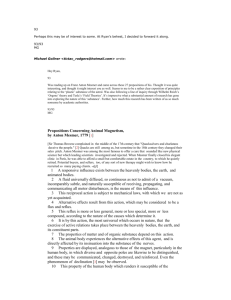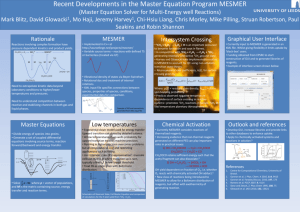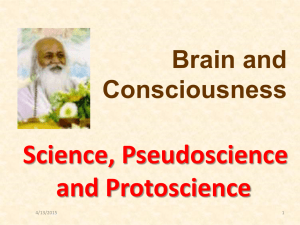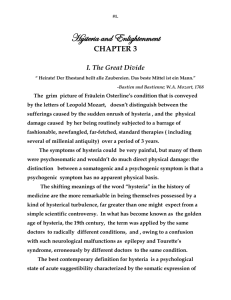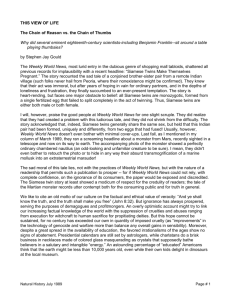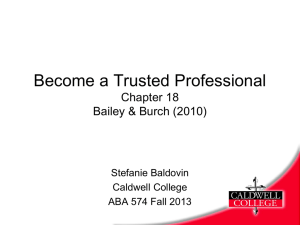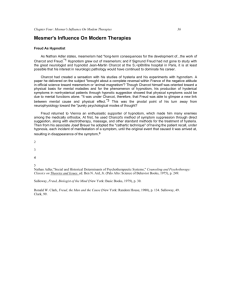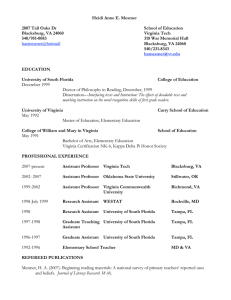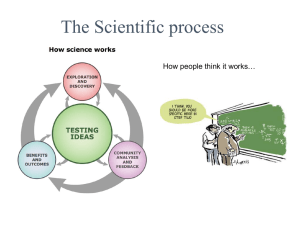Toward The Science of Psychology: Early Experimentalists
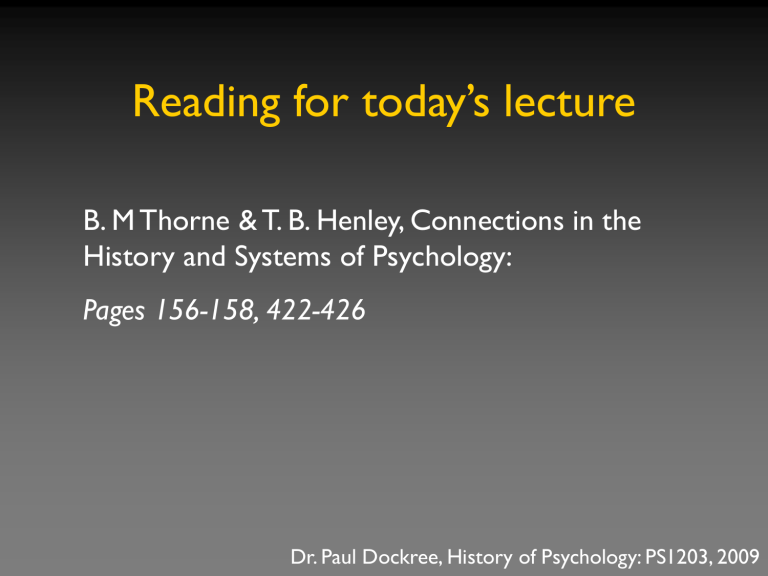
Reading for today’s lecture
B. M Thorne & T. B. Henley, Connections in the
History and Systems of Psychology:
Pages 156-158, 422-426
Dr. Paul Dockree, History of Psychology: PS1203, 2009
Pseudoscience and Psychology
Dr. Paul Dockree, History of Psychology: PS1203, 2009
What is Pseudoscience?
• Pseudoscience is defined as a body of knowledge, methodology, belief, or practice that is claimed to be scientific or made to appear scientific, but does not adhere to the scientific method
• Pseudoscientific beliefs are remarkably common even among welleducated individuals (Gallop Poll, 2001; NSF, 2002).
• Pseudoscientific beliefs are resistant to change. Even people with degrees in the sciences often hold such beliefs.
Identifying pseudoscience
• Use of vague, exaggerated or untestable claims
• Lack of clear definitions of variables and methods to measure these variables
• Unexplained technical jargon alert!
• Lack of boundary conditions: Assertions that cannot be
falsified by observation or physical experiment
• Lack of effective controls, such as placebo and doubleblind, in experimental design
Identifying pseudoscience
• Lack of openness to testing by other experts and lack of progress
• Evasion of peer review before publicising results.
• Lack of openness. Failure to provide adequate. information for other researchers to reproduce the claims.
• Lack of self correction in view of contradictory evidence.
Mesmer and “Animal Magnetism”
• Franz Anton Mesmer (1734-
1815)
• Mesmer received a doctorate in medicine from the
University of Vienna and listed other ‘unaccounted for’ degrees
• After graduating he married an older wealthy widow, became a socialite, befriended musical celebrities
Mesmer and “Animal Magnetism”
• Mesmer’s ideas on magnetism influenced by local Jesuit priest –
Father Maximillian Hell
• Mesmer believed that many maladies were caused by animal magnetism, magnetic fluids running through all humans & animals
• Treated patients suffering from
“hysterical fever” by requiring patients to swallow medicine contain iron particles and then applied magnets to parts of the body
• Patient enters a ‘crisis state’, then symptoms subside
Mesmer and “Animal Magnetism”
• In subsequent patients,
Mesmer suggested what they should expect (ie., crisis state upon application of the magnets).
• He then tried treatments
without magnets, just passing his hands over patients’ bodies. This worked too.
Mesmer’s Demise
• Mesmer became embroiled in scandal over the treatment of Maria-Theresia Paradis – a psychogenically blind teenaged piano prodigy.
• Mesmer took to the Parisian stage charging massive fees for mass-produced magnetic cures.
• Eventually, Mesmer’s practice was investigated by the blue-ribbon scientific commission and animal magnetism was deemed unscientific and without proof or foundation.
Magnetism Today!
• The pure wooden magnetic therapy health care shoes, adopting traditional Chinese medicine acupuncture treatment principle and physical magnetic field principle, making the permanent magnet produce line of magnetic force, stimulating the meridian point of feet, and accelerating blood circulation of feet and balancing the yin yang. Range of applicability: soft tissue injury, neuralgia, inflammation pain; improving sleep, remitting muscle cramp, relieving facial tic.
Franz Joseph Gall
• Franz Joseph Gall (1758-
1828) – a Austrian physician and anatomist
• Gall made some important contributions to science linking higher mental functions to the volume of cortex
• He proposed a new version of the medical doctrine of localisation of function
From Physiognomy to Phrenology
Physiognomy is a theory based on the idea that by looking at a person's facial features, we can determine the inner trait, personality and characteristics of that person
• In 1806, Charles Le Brun created a series of comparative drawings of human and animal faces depicting the physiognomy theory.
• He believed that if a human's face resembled an animal, he or she would have the same character traits of that type of animal. For example, one who looked like a lion would have that fierce quality.
• Johann Kaspar Lavater, 1741-1801 believed could reveal the often disguised secrets of one's moral nature.
Phrenology
• Gall assumed that welldeveloped mental faculties would correspond to welldeveloped parts of the brain
• The organs corresponding to well-developed faculties of the brain would be larger than organs corresponding to lessdeveloped faculties
• There relative size would be registered on the skull as bumps overlying the developed organ
Phrenology
• Methodology: matching psychological traits with ‘size of bump’ on the skull.
• Gall drew up a long list of faculties – destructiveness, friendship, and language, for example.
• Gall’s conception pointed in two directions: one scientific and one pseudoscientfic (Johann Spurzheim)
Phrenology
• Phrenology gave rise to the invention of the psycograph by Lavery and White
• This device netted its owners about
$200,000 at the 1934 Century of Progress
Exhibition in Chicago
Pseudoscience & “Brain Exercises”
• Brain Gym (see Ben Goldacre’s book “Bad
Science”)
• A series of pseudoscientific exercises to ‘enhance the experience of whole brain learning’
• “ ‘Drink a glass of water before Brain Gym activities’, the say.
‘As it is a major component of blood, water is vital from transporting oxygen to the brain.’ Heaven forbid that your blood should dry out. This water should be held in your mouth, they say, because then it can be absorbed directly from there into your brain.” (Goldacre, Pg 13)
Pseudoscience & “Brain Exercises”
• ‘Hook-up’ exercises: “…(where you press your fingers against each other in odd contorted patterns) this would ‘connect the electrical circuits in the body, containing and thus focusing both attention and disorganised energy’” (Goldacre, Pg 14-15)
• “if they wiggled their ears with their fingers as per the Brain
Gym textbook it would ‘stimulate the reticular formation of the brain to tune out distracting, irrelevant sounds and tune into language’” (Goldacre, Pg 15)
• The Seductive Allure of Neuroscience Explanations. Deena Skolnick
Weisberg, Frank C. Keil, Joshua Goodstein, Elizabeth Rawson,
Jeremy R. Gray. Journal of Cognitive Neuroscience March 2008,
Vol. 20, No. 3: 470–477.
Science and the Media
• Public belief of an association between the MMR vaccine and autism
• Large range of epidemiological surveys do not support the link.
The adverse effects of not taking the vaccine argue against its withdrawal.
Pseudoscience and Therapy
• Arthur Janov created primal therapy as the means of eliciting repressed pain and trauma. Janov claims that therapeutic progress can only be made through direct emotional experience, which allows access to the source of psychological pain in the lower brain and nervous system. Janov believes that psychological therapies which involve only talking about the problem (referred to as
"Talking Therapies") are of limited effectiveness because the cortex, or higher reasoning area of the brain has no ability to affect the real source of psychological pain in other areas of the brain.
• http://smashingtelly.com/category/pseudo-science/
